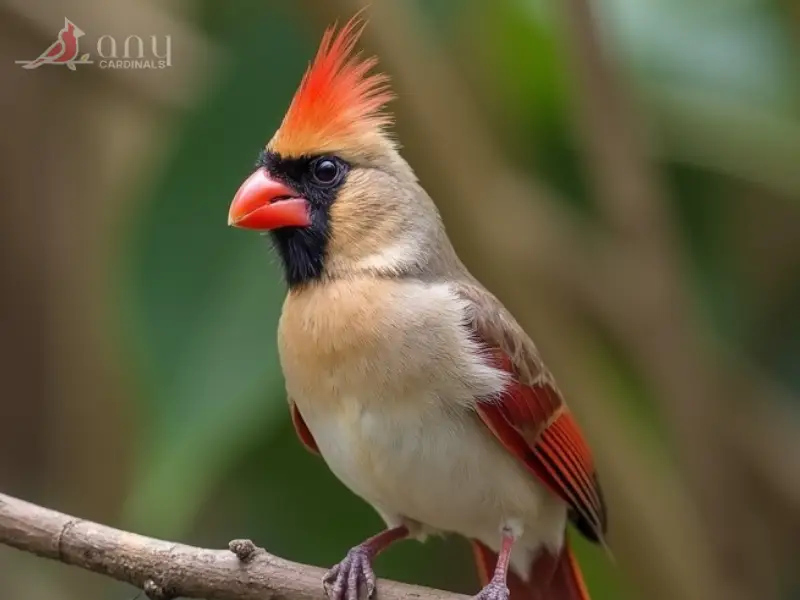The Red-crested Cardinal is a medium-sized songbird that allures numerous people with its enchanting plumage and melodic songs. Many people wait for a prolonged period to see this charmer.
Luckily, a few people get to see it, and others don’t. Some of those who catch sight of this bird confuse it with the Northern Cardinal since it shares the cardinal’s similar name and partial color.
While the truth is it is distinctly different from the Northern Cardinal and has varied characteristics. That’s what we are about to discover through this content. Ensure you read the entire article to learn more about this vibrant bird.
Related Articles
Red-crested Cardinal Profile – Everything at a Glance
| Name | Red-crested cardinal |
|---|---|
| Scientific Name | Paroaria Coronata |
| Common Names | Brazilian Cardinal |
| Origin | Argentina, Bolivia, Brazil, Paraguay and Uruguay |
| Size | 7.5 inches long |
| Weight | 30-35 g |
| Lifespan | 15 years |
| Physical Features | The head, crest, and upper breast are bright red, but their legs are dark, and the bills are silver-gray/white. |
| Temperament | Males tend to become bellicose during mating season. |
| Similar Species | Red-cowled Cardinal and Yellow-billed Cardinal |
Overview of This Magnificent Bird
Introduced in 1832 by the French naturalist Charles Lucien Bonaparte, the Red-crested cardinal is a medium-sized passerine bird derived from the tanager family Thraupidae.
Despite bearing the cardinal name, this beautiful bird isn’t related to the Cardinalidae family like the Northern cardinal. Nonetheless, it is a close relative to Red-cowled and Yellow-billed cardinals.

This attractive bird species is a habitat of Brazil’s Rio Grande do Sul, the southern part of the Pantanal, northern Argentina, Bolivia, Paraguay, Uruguay, Hawaii, Puerto Rico, and Chile.
That’s a little overview of the Red-crested Cardinal. We will now learn in-depth about this magnificent bird.
History and Origins of Red-crested Cardinal
Although there is no accurate data on when this songbird was first spotted, researchers believe the Red-crested Cardinal has been venturing into southern South America for at least a million years.
In 1776, John Frederick Miller, an English illustrator, created a depiction of the Red-crested Cardinal for his work “Icones animalium et plantarum.” He also invented its binomial name – Loxia coronata.
Later, this bird became one of six species in the Paroaria genus and was introduced by Charles Lucien Bonaparte – a French naturalist – in 1832.
As this songbird is commonly found in South America, indigenous people here cherish this mid-sized songbird. People also believe in many myths and folklore related to this bird.
For instance, the Tupi-Guarani people associate this bird’s vibrant red with fertility rituals. Furthermore, they think the Red-crested Cardinal’s calls are messages from the spiritual world!
In their culture, this bird symbolizes passion, fertility, and the power of song. Globally, the Red-crested Cardinal’s appearance signifies hope, new beginnings, love, loyalty, joy, and beauty.
We believe all this information gives you an overview of the history and origin of the Red-crested Cardinal.
Let’s now delve deeper into other information about this enchanting songbird.
Physical Characteristics of Red-crested Cardinal
Learn all the ins and outs related to the physical characteristics of the Red-crested Cardinal by thoroughly reading this section.
Distinctive Appearance: The Red-crested Cardinal boasts a unique distinctive appearance. It (the adult bird) features a flaming red head and a crest. Its crown is crimson, and its beak is bright white.
Like the Northern Cardinal, it also owns a black mask around its eyes, which is why many people confuse the Red-crested Cardinal with the Northern one.

This bird’s back and wings are dark blue-gray, while its belly and breast are white. Lastly, its legs tend to be dark.
Size and Measurements: Adult red-crested cardinals typically measure 7.5 inches (19 centimeters) in length.
Weight: Since it’s a medium-sized songbird, it weighs around 30 to 35 g.
Plumage Variation: Male Red-crested cardinals come with comparatively brighter and deeper red plumage than females. Their red feathers can turn cherry red or dull orange-red based on age, health, and diet.
Apart from this, the Red-crested Cardinal’s white plumage on the belly, breast, and undertail can significantly vary due to varied factors.
Juvenile Features: Juvenile Red-crested cardinals have similar physical features to adult birds, but their heads and bibs remain brownish instead of red.
Wing and Tail Features: The Red-crested Cardinal features 20 to 22 cm long and rounded wings. These wings are predominantly gray. Speaking of its tail, this bird has a gray tail, helping it effortlessly steer and maneuver.
Distribution and Habitat of Red-crested Cardinal
Though we have already given you a glimpse of the Red-crested Cardinal’s geographic location, you will know in-depth about its habitat and other relevant factors in this part of the article.
Geographic Distribution:
This medium-sized songbird has a distinct geographic distribution. You can spot the Red-crested Cardinal in Argentina (northern and central), Bolivia (northern and eastern), Brazil (southern and southwestern), Paraguay (western and central), and Uruguay (throughout).
Besides these locations, you can also witness the Red-crested Cardinal in Puerto Rico and Hawaii.
Habitat Preferences:
The Red-crested Cardinal thrives exceptionally well in varied semi-open habitats within its native and introduced ranges.
Primarily, this bird chooses tropical dry forests, parks, gardens, scrublands, and grasslands featuring low vegetation.
Migration and Seasonal Movements:
The Red-crested Cardinal is a non-migratory bird that prefers to remain within its established range throughout the year.
Nonetheless, this bird can relocate due to food scarcity, deforestation, threats, and other factors.
Threats and Conservation Status:
Like many other songbirds, the Red-crested Cardinal faces various threats. For example, these birdies regularly deal with the threat of habitat loss because of deforestation, agricultural expansion, and human settlements.
The Red-crested Cardinal also remains lucrative among illegal traders who want to trap these birdies and trade them illegally.
Despite encountering all these threats, this vibrant bird isn’t an endangered species. The IUCN Red List of Threatened Species lists the Red-crested Cardinal as Least Concern.
Behavior and Physical Traits of Red-crested Cardinal
Do you know how social or aggressive the Red-crested Cardinal is? Or what activities does it perform during the daytime? If you don’t know, this section will enlighten you.

Differences Between a Red-crested Cardinal and a Cardinal:
Although both Cardinals (we are referring to the Northern Cardinal) and the Red-crested Cardinal have similar names and appearances, they are distinctly different in physical features.
For instance, the Red-crested Cardinal belongs to the tanager family Thraupidae, while the Northern Cardinal’s family is Cardinalidae. Additionally, Red-crested cardinals boast red heads, crests, and bibs. They also have gray backs and white underparts.
On the contrary, the Northern Cardinal’s plumage, especially males’ plumage, is entirely red, and these birds feature a black mask around their faces.
Another difference between these birds is that the Red-crested Cardinal is slightly smaller than the Northern Cardinal. These are some primary differences between these two birds.
Diurnal and Social Behavior:
The Red-crested cardinal tends to be active during the day and sleep at night, meaning it’s a diurnal bird. During the daytime, this songbird engages in various activities, including searching for food, building nests, protecting territories, and producing mating or alarming calls!
Now, let’s talk briefly about how social this colorful bird is. Well, the Red-crested Cardinal is quite social, as you can spot it sharing food with other birds while feeding from a bird feeder.
This bird loves to form a long-term pair (monogamous), and you can often notice it in a small group of birds during breeding and foraging. Given all these, it is evident that the Red-crested Cardinal is a social bird.
Breeding Season Behavior:
When the Red-crested Cardinal’s breeding season begins (timing varies based on the location), males perform various activities in order to attract females. For instance, male birds raise their crests, puff out their chest feathers, and loudly sing whistling songs.
Aggressive Mating Behavior:
The phrase “aggressive mating behavior” doesn’t go with the Red-crested Cardinal since this birdie doesn’t show physical aggression during mating.
As you know, male birds tend to sing and dance to attract females. However, they may rarely show aggression, such as chasing while competing with other contenders to attract a single female.
Flight Characteristics:
The Red-crested Cardinal can undertake powerful flight over short distances, thanks to its strong wings. Besides this, males can conduct undulating flights while loudly singing to alarm others in their territory about the presence of rivals.
This bird is agile and can perform a speedy flight when threatened. It can excel at weaving through dense foliage by flying to escape predators.
Diet and Feeding Habits:
The Red-crested Cardinal is an omnivore. It mainly eats plant seeds, fruits, berries, and insects. Also, it commonly consumes insects such as waxworms, mealworms, and small crickets. When foraging, these birds seek seeds and small arthropods on the ground.
Reproduction and Development of Red-crested Cardinal
Here, we will discuss everything about the Red-crested Cardinal’s reproduction and development process. Hence, keep reading to enrich your knowledge.
Reproduction and Breeding Habits:
The breeding season for the Red-crested Cardinal kicks off in early October and runs through late February (applicable to birds in South America).
During these months, male birds are responsible for building cup-shaped nests. These birds take 4-5 nesting attempts over the breeding season.
On the contrary, females lay 2-5 eggs and incubate them for around 12-13 days. Both male and female birds contribute to every reproduction stage, from building nests and incubating eggs to feeding and protecting hatchlings. They ensure young cardinals receive optimal care for thriving well.
Nesting Behavior and Habitat Selection:
Though male Red-crested cardinals are in charge of building nests, females also cooperate in making nests. Both birds visit open woodlands, shrublands, and edges of forests to collect vegetation and twigs.
They prefer dense foliage or thorn plants to construct their nests. While selecting nesting sites and building nests, they prioritize abundant food sources and easy access to water. That’s why these birds make several attempts to build nests during the breeding season.
Egg Laying and Incubation:
When the breeding season starts, once the Red-crested cardinals build the final nest, females start laying one egg per day until the hatch is complete (the hatch consists of 2-5 eggs).
Afterward, females incubate those eggs for around 12-13 days. In the meantime, males feed her and protect her and their territory.
Parental Care and Nestling Stage:
The Red-crested Cardinal displays dedicated parental care throughout the nesting stage, typically lasting 13 to 16 days. At this time, the female bird always stays close to the chicks while the male performs the duty of feeding and protecting his family.
Apart from this, both birdies play a crucial role in maintaining and cleaning their nest. They diligently remove fecal sacs the nestlings produce to keep the nest clean and hygienic.
Juvenile Plumage and Development:
The Red-crested Cardinal undergoes an interesting transformation from the moment it is born. Newly hatched birds feature a layer of down and tend to be pink.
Within a week, these little birds develop brown and gray feathers on their wings and backs. Once they become fledglings in 13 to 16 days, their plumage completely develops, yet it still lacks the signature red coloration of adults.
They grow their first red feathers on their tail once they become 6 to 7 months old. With age and time, they grow red feathers in other areas (belly, breast, head, etc.) of their body. This way, the Red-crested juvenile cardinal develops its plumage.
Reproductive Success and Survival Rates:
The reproductive success and survival rates of the Red-crested Cardinal depend on varied factors. According to several sources, each nest featuring two to five eggs has an estimated chance of survival of 14% to 28.5%
Sounds and Vocal Behavior of Red-crested Cardinal
The Red-crested Cardinal produces sweet, melodic, and slow songs. This birdie generates high-pitched whistles that often get slurred. It’s songs sound much like “tchew tweet chuu tweet chuwiit tuup tweet chuu.“
Frequently, this bird produces one or more parts of the songs as alarm calls. Alongside making loud sounds, the Red-crested Cardinal also yields a soft chirp sound. Interestingly, in captivity, this bird tends to imitate other birds.
Interesting Facts About the Red-crested Cardinal
Here are some intriguing facts about this vibrant songbird.
- This bird has been featured in postage stamps in their native Argentina, Brazil, and Uruguay, thanks to its beauty.
- While seeds and insects are their staple diet, Red-crested cardinals enjoy a sweet treat. They consume delicious fruits like berries.
Frequently Asked Questions
What is the Red Bird Mistaken for a Cardinal?
Many people confuse the Summer Tanager with the Northern Cardinal since both birds have the signature red feathers. However, the Summer Tanager doesn’t feature the significant black mask as a Northern Cardinal.
Are Red-crested Cardinals Rare?
No, the Red-crested Cardinal is a common bird in South America and other areas where it has been introduced. FYI, IUCN has listed this birdie as a Least Concern species, meaning it isn’t rare.
Can Red-crested Live with a Cardinal?
As you know, Red-crested and Northern cardinals are social and seen to eat foods from bird feeders with other birds. A Red-crested Cardinal may live with a Northern Cardinal in an appropriate environment with proper care. However, there is no research today validating this statement.
Rounding Up
The Red-crested Cardinal is a charismatic bird in South America. This colorful songbird attracts ornithologists and bird watchers worldwide with its vibrant plumage and cheerful and melodious calls.
If you are a birdwatching enthusiast, you will surely be amazed to spot this bird – indeed, it will be a memorable experience. However, that’s all for this comprehensive article. We hope it provides the valuable information you were seeking. Happy birding!
Article References
- https://en.wikipedia.org/wiki/Red-crested_cardinal
- https://hawaiibirdingtrails.hawaii.gov/bird/red-crested-cardinal/
- https://nationalzoo.si.edu/animals/red-crested-cardinal
- http://hbs.bishopmuseum.org/birds/rlp-monograph/pdfs/07-ZOST-ESTR/RCCA.pdf
- https://www.riverbanks.org/subsite/pact/cardinal%20profile.pdf
- https://birdsoftheworld.org/bow/species/reccar/cur/introduction
- https://www.jstor.org/stable/23324557
- https://louisvillezoo.org/animalsandplants/cardinal-red-crested/
- https://journals.tdl.org/watchbird/index.php/watchbird/article/view/185/176
- http://sedici.unlp.edu.ar/handle/10915/107959

